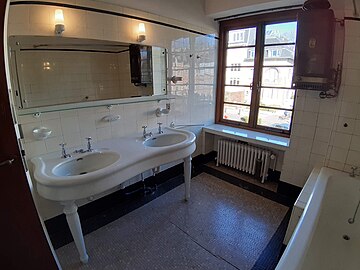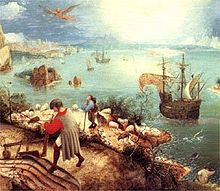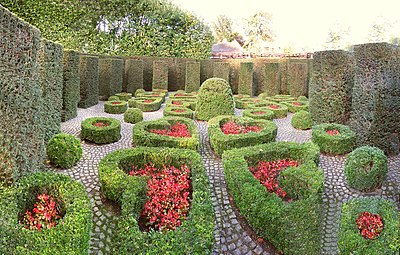Van Buuren Museum & Gardens
- Amsterdam School
- Art Deco
The Van Buuren Museum & Gardens (French: Musée & Jardins van Buuren; Dutch: Van Buuren Museum & Tuinen) are a former private house with extensive gardens, now a museum and park in Uccle, a municipality of Brussels, Belgium.
The house was built from 1924 to 1928, in the Amsterdam School style, for the banker and art collector David Van Buuren and his wife Alice Piette. It was decorated by both of them as a Gesamtkunstwerk to present their art collection, which extends from the 15th to the 20th century, in a rich Art Deco interior. The house is surrounded by gardens designed by the landscape architects Jules Buyssens in 1924 and René Pechère [fr] in 1968–1970.
The private house became a museum in 1975 according to Alice Van Buuren's will. It was declared a National Heritage Site in 2001.[2]
History
David Van Buuren (1886–1955) was born into a Jewish family in Gouda, Netherlands.[3] He settled in Brussels in 1909 to become an important private banker. He married the Belgian Alice Piette (1890–1973) in 1922. David Van Buuren asked his nephew and architect Johan Franco to start working on the plan for his future house in Brussels.[4] From 1924 to 1928, the Van Buurens commissioned the architects Léon Govaerts and Alexis Van Vaerenbergh to build their house on Léo Errera Avenue in Uccle following Franco's sketches.[4][5]
From 1928 to 1970, the Van Buurens hosted people such as Raoul Dufy, Jacques Prévert, René Lalique, Sergei Diaghilev, Erik Satie, René Magritte and David Ben-Gurion. The private house became a museum in 1975 according to the testament of Alice Van Buuren.[6]
House
Built in 1928 by Léon Emmanuel Govaerts and Alexis Van Vaerenbergh, the house features exterior architecture typical of the Amsterdam School, while the interior decoration constitutes a unique Art Deco ensemble created by Belgian, French and Dutch interior designers. The Van Buuren couple had turned their villa into a "living conservatory", where rare furniture, carpets, stained glass windows, sculptures and paintings by international masters remain in place, in the intimacy of a private "house of memory", which became a museum in 1975 under Alice Van Buuren's will,[7] and which comprises a series of rooms that can be visited: the vestibule, the cloakroom, the hall and the staircase, the cozy corner, the music room, the black living room, the dining room, the study and the studio.[6]
"This residence combines the warmth of a home—that of the banker and patron David Van Buuren and his wife—with the richness of a museum."[8]
-
 Hall and staircase
Hall and staircase -
 Living room
Living room -
 Dining room
Dining room -
 Bathroom
Bathroom
Collections

David Van Buuren decorated his house with paintings by James Ensor, Joachim Patinir, Pieter Bruegel the Elder, Hercules Seghers, Pieter Jansz Saenredam, Tsuguharu Foujita, Kees van Dongen, Vincent van Gogh, Henri Fantin-Latour, Rik Wouters, Gustave De Smet, Xavier Mellery en Constant Permeke. David was the patron of the expressionist painter Gustave van de Woestijne. Van Buurens collections consists of 32 paintings of Van de Woestijne.[9]
The living room is decorated with a rich collection of modernist carpets by the Dutch designer Jaap Gidding,[10] and a grand piano made of rosewood designed by Julius Blüthner.[11] Jan Eisenloeffel designed the 500 kg (1,100 lb) Art Deco chandelier in the entrance hall.[12][3][13]
On 16 July 2013, the paintings Shrimps and Shells by James Ensor, The Thinker by Kees Van Dongen, and eight small works by old masters were stolen.[14][15]
Gardens
The gardens, begun in 1924, originally covered 26 a (28,000 sq ft) and now cover 1.5 ha (3.7 acres). They are divided into three parts. The first, and oldest, is a Picturesque Garden by the landscape architect Jules Buyssens that recalls the spirit of the Roaring Twenties and shows the geometrical ideas of Art Deco. The second, the Labyrinth, is inspired by the Song of Solomon and in 1968 was decorated with seven sculptures by the sculptor André Willequet. The third, Garden of the Hearts, was designed by the landscape designer René Pechère [fr] in 1970 and brings a touch of romanticism to the park. There is a great harmony of style and time between the Buyssens garden and the Art Deco house. Alice considered René Pechère's gardens, added 45 years later, as a complement of her villa. The gardens can be visited year-round.[16][17][18]
In 2015, the restoration of the gardens (carried out in stages in 2009–2012 and 2018–2019) received the Europa Nostra Award for European cultural heritage.[19] In 2023, they became the first Belgian site to be included in the European Route of Historic Gardens.[20]
-
 A view of the house through part of the restored garden (2019)
A view of the house through part of the restored garden (2019) -
 Garden of the Hearts by René Pechère
Garden of the Hearts by René Pechère
See also
References
Citations
- ^ Anspach 2007.
- ^ Ministère de la Région de Bruxelles-Capitale 2001, p. 3.
- ^ a b Swimberghe 2001, p. 115.
- ^ a b Ministère de la Région de Bruxelles-Capitale 2001, p. 7.
- ^ Carez 1996, p. 24
- ^ a b "House". Van Buuren Museum. Retrieved 10 November 2023.
- ^ Pierre Groppo, La collectionneuse, Vanity Fair, no. 41, November 2016, p. 126–128
- ^ "Van Buuren Museum & Gardens". Brussels Museums. Retrieved 10 November 2023.
- ^ "Works". Van Buuren Museum. Retrieved 10 November 2023.
- ^ Day 2002, p. [page needed].
- ^ Conseil de la Musique de la Communauté Française de Belgique 1992, p. 169-170.
- ^ Ministère de la Région de Bruxelles-Capitale 2001, p. 4.
- ^ "Aus liebe zu den künsten" (PDF). Architectural Digest (in German). May 2008.
- ^ "Lightning raid on the van Buuren museum". News of the Art World. 23 July 2013. Archived from the original on 14 July 2014. Retrieved 21 August 2013.
- ^ "Vol dans un musée de Bruxelles". Le Monde (in French). 16 July 2013. Retrieved 21 August 2013.
- ^ Taylor 2006, p. 42
- ^ Pechère 1987
- ^ Pechère 2008, p. 192
- ^ Guy Duplat (30 August 2023). "Prestigieuse reconnaissance pour les jardins van Buuren". La Libre.
- ^ Lauren Walker (30 August 2023). "Brussels park first in Belgium to be included in prestigious cultural route". Brussels Times.
Bibliography
- Ministère de la Région de Bruxelles-Capitale (28 June 2001). "Arrêté du gouvernement de la Région de Bruxelles-Capitale classant comme monument la totalité de la villa - musée David et Alice van Buuren y compris du mobilier" (PDF) (in French). Retrieved 18 August 2013.
- Carez, Christian (1996). Bruxelles Art Déco: 1920–1930 (in French). Éd. Norma. p. 24. ISBN 978-2-909283-26-5. Retrieved 19 August 2013.
- Lechien-Durant, Françoise; Eeckhout, Paul (1995). Musée David & Alice van Buuren: maison de mémoire (in French). Bruxelles: Racine. ISBN 9782873860431.
- Taylor, Patrick (2006). The Oxford Companion to the Garden. Oxford: Oxford Univ. Press. ISBN 9780198662556.
- Swimberghe, Piet (1997). Vivre à Bruxelles (in French). Lannoo. pp. 140–145. ISBN 9020949780. Retrieved 4 September 2011.
- Conseil de la Musique de la Communauté Française de Belgique (1992). "Musée David et Alice van Buuren - piano Blüthner". Les instruments de musique à Bruxelles et en Wallonie: inventaire descriptif (in French). Liège: Mardaga. pp. 169–170. ISBN 9782870094891. Retrieved 4 September 2011.
- Day, Susan (2002). Art deco and modernist carpets. San Francisco: Chronicle Books. ISBN 9780811836135.
- Pechère, René (1987). Jardins dessinés: grammaire des jardins. Atelier d'art urbain. Retrieved 17 August 2013.
- Pechère, Jean-Claude (2008). "Le labyrinthe d'Alice van Buuren". Le soleil et l' ombre. Lannoo Uitgeverij. pp. 159–164. ISBN 978-2-87386-548-1. Retrieved 18 August 2013.
- Swimberghe, Piet (2001). Belgique Vue de L'interieur (in French). Racine. pp. 114–119. ISBN 9789020945652. Retrieved 4 September 2011.
- Anspach, Isabelle (2007). Van Buuren musée et jardins. Brussels: Fonds Mercator. ISBN 978-90-6153-770-0.
External links
 Media related to Museum Van Buuren at Wikimedia Commons
Media related to Museum Van Buuren at Wikimedia Commons- Maslaton Oster, Joelle (5 December 2009). "Van Buuren - Joelle Magazine". joellemagazine.com. Retrieved 18 August 2013.
- "Van Buuren Gardens". European Route of Historic Gardens. 2023. Retrieved 22 October 2023.


















